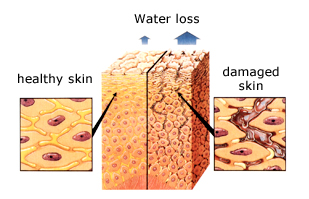 The skin is the largest organ of the human body.
The skin is the largest organ of the human body.
- Area: approx. 1.5 – 2 sqm
- Weight: approx 10% of bodyweight (depending on stored water and fat)
- Total thickness: approx. 1 mm (may vary greatly depending on body part and individual condition)
- Thickness of the horny layer: approx. 0.05 mm
- pH-value:: 4 – 7 (depending on body parts)
Our skin with its outer corneal layer (stratum corneum) over which lies a hydrolipid film, forms the natural barrier between our bodies and the environment.
The corneal layer comprises several layers of dead skin cells that are constantly being replaced by the shedding of old cells and the growth of new cells from the deeper skin layers. Fatty substances (lipids) surround the corneal cells (corneocytes) like mortar around the bricks in a wall.
The top priority needs to be to retain the natural barrier function of the skin and to support its regeneration.
 Dry skin may be an indication of serious skin damage. This is the point at which skin protection and skin care measures should, at the latest, be taken or improved.
Dry skin may be an indication of serious skin damage. This is the point at which skin protection and skin care measures should, at the latest, be taken or improved.
Hazards
Fat and moisture loss as a result of severe stress or strain, the natural barrier function of skin may be damaged. Special hazards caused by:
- frequent/continuous contact with watery substances such as water-miscible cooling lubricants, acids and alkalis, cleaning fluids and also water and damp food
- intensive cleaning of the hands after contact with oils, grease and heavily adhesive dirt such as paints, adhesives
- sweating and contact with the moisture inside tight-fitting protective gloves when worn for a long time.
Even slight but constant stress that does not leave any visible damage even over longer periods, will have a negative effect on the skin at some point.
Skin protection
Skin protection products can largely prevent contact with hazadous and skin damaging substances and when used regularly, reduce the risk of skin desease. They should be selected according to the specific workplace factors the skin will be exposed to.
General purpose products are always a compromise.
A difference should be made between:
- oily, greasy dirt
- highly adhesive dirt
- wet/damp areas
- UV radiation
- soft skin from wearing protective gloves/clothing
Cleaning the skin
The selection of an appropiate product should be based on the type of substance to be removed. In order not to stress the skin unnecessarily, the mildest possible cleansing agent should be used.
In order to avoid stressing the skin unnecessarily, cleansing should be as gentle as possible. This is achieved by:
- applying skin protection products before working
- avoiding the use of cleansers containing abrasives and solvents as well as mechanical aids such as pumice stones or brushes
- thorough rinsing with plenty of water and drying carefully
Improper cleansing is one of the main causes of skin diseases. Thinners and solvents should never be used for cleaning the skin.
Skin care
Skin should be cared for regularly both during and after work. Skin care agents protect against rough, dry and cracked hands and help to maintain the natural protective function of the skin thus reducing the likelihood of skin deseases.
Cared-for skin not only looks better, it is also more resistant to day-to-day stress.
